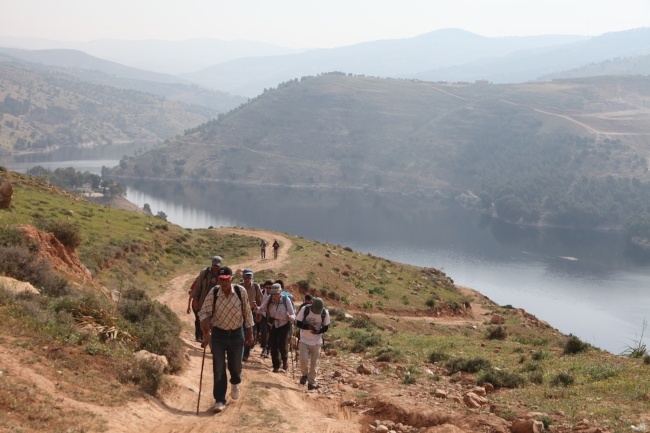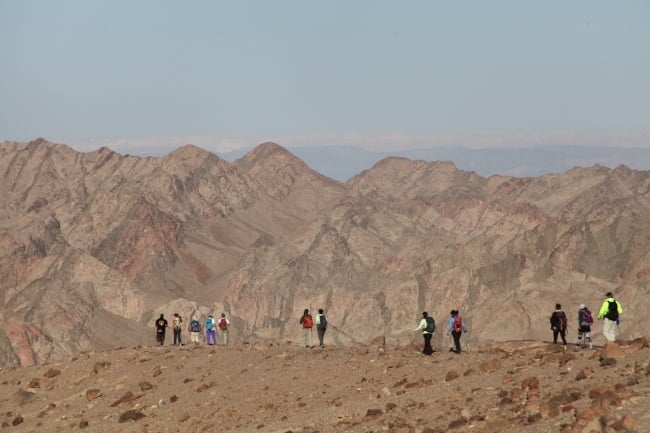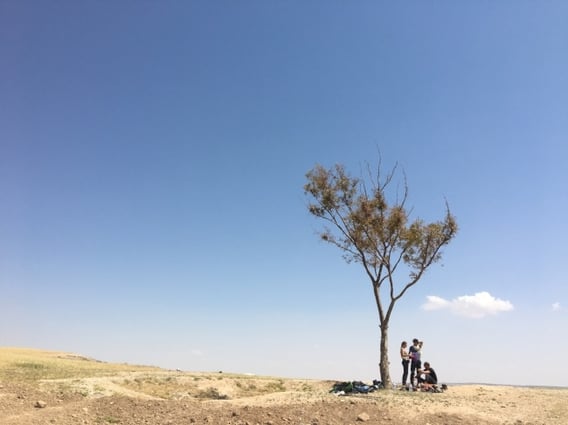
The Mohammads have taken to calling me “Sheikh Nawaf”—even introducing me as such to strangers we meet—and yet it took me almost a week to get a proper translation of my nickname. In our hours spent hiking, the linguistic question sparked a small debate among the Arabic-speakers in our group.
“Nawaf is the highest place . . .” said one. “You know when you are climbing and then you can’t climb any higher?”
“Like a plateau,” another joined in, “They are calling you ‘plateau’.”
“As in, I’ve already plateaued?” I wondered out loud.
“No, no,” another countered. “It’s the peak—it means mountain peak, because you are the tallest.”
Technically, Nawaf means “Zenith”, which I know from this last week’s hiking up and over several nawaf. The Jordan Trail delivers an impressively honest topographical cross-section of the country, even if that truth becomes painful as you bounce between some of the lowest and highest points in the country.
It is precisely this constant back-and-forth dropping to the valley floor followed by rapid ascent up incredible peaks that can be so hard on hikers. And while this fourth section is only 75 km (47 miles) long, the “Three Wadis” (Zarqa Ma’in, Wadi Hidan, and Wadi Mujib) is considered the most physically challenging section of the entire Jordan Trail.
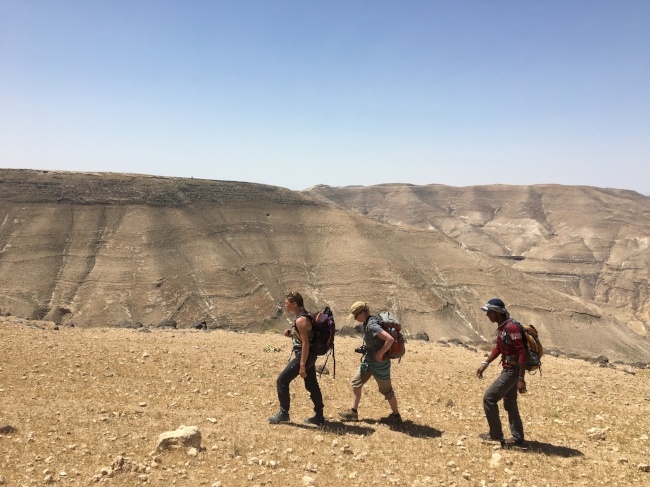
Each Day Brings A New Challenge
Each of our daily hikes is graded as one green boot (easy), two yellow boots (moderate), or three red boots (difficult), and this entire past week has been designated three red boots.
Zarqa Ma’in was a mild introduction to this new challenge, in which we climbed all day, did a wee descent and shuffled across a small stream, then hiked back up the other side of the canyon. Wadi Hidan, on the other hand, demanded a whole lot more effort. From dawn until lunch, we were climbing, sweating, climbing, up and up and up to what felt like impossible heights. Then, after all that effort, we peered over the other side and looked straight down to the squiggly line of green that snaked at the bottom of the valley. That was Wadi Hidan, and it took us the rest of the day zigzagging and skidding our way back down to the bottom. This kind of hiking wears on the soul because it feels as if we are deleting all of our accomplishments, day after day—after all that physical effort to go up, we just turn around and go right back down to the bottom.
It is the Greek myth of Sisyphus, who every day rolled his massive boulder up a mountain, only to watch it roll back down to the bottom, forcing him to begin the task anew. Every morning we woke up in a tent at the bottom of the mountain, and every day we climbed to the top—but the next morning, we found ourselves at the bottom of another mountain.
The upside of this section were the wadis themselves--small rivers flowed through all these desert valleys, so that our reward for the day’s work was a quick swim in the frigid natural pools. After four days’ camping, to bathe in any fashion feels like bliss.
I am not entirely sure where the dread and apprehension around Wadi Mujib originated, but as we neared this final wadi, our group seemed tense and anxious. Somehow, even though the Jordan Trail is too new and too young for hikers to have collectively designated these few miles as “rough”, Wadi Mujib has already earned the title.
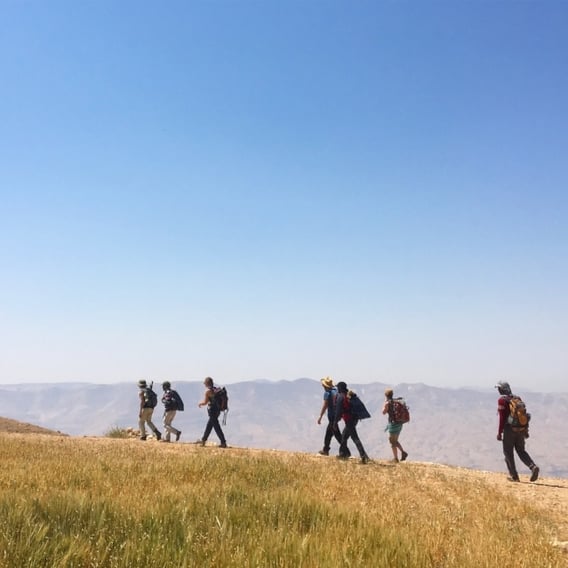
After a long lunch beneath a lone tree atop an empty green plateau, we reached the edge of Mujib and began our descent. Suddenly we were single-file, bending our knees and concentrating like never before, judging where to step and walking in mere inches, shuffling timidly down the mountain.
Falling for the Beauty of Jordan
I have decided that going downhill is much more difficult than going uphill, and going downhill for hours on end is something you feel in your knees and thighs for days. Hiking into Mujib felt more like slow-motion skiing on slippery dirt and loose stone—I was especially glad to have a guide who could lead us in favor of one narrow sheep track over another, which might lead to some sheer drop-off. Bit by bit, we head down and slowly I became more comfortable with the routine, chatting easily with the hikers in front of me, and refusing to look to my left, where the slope ended in a severe cliff several hundred meters high.
I stepped down and put my left foot on a large grey stone—about the size of a basketball—but right as I pivoted, I felt the rock slide away, rolling down the steep slope and tumbling off the bare edge of the cliff. My own body followed, first dropping into a kind of sideways splits that would have earned me points in a gymnastics competition, but won me no favors on a mountain slope. Instead, my body rolled into a somersault as I desperately grabbed at everything—a thorny shrub, some dry twigs, another stone—but that stone also tumbled away and I continued to fall.
No—my life did not flash before my eyes, but I did have the distinct thought that if I did not grab onto something solid in the next two seconds, then my body was going right over the edge. And so as I tumbled, I reached out both arms and wrapped them around the final boulder, swinging the rest of my body around like John Wayne mounting a horse. Only this was not a horse, but a massive hunk of limestone, so that my knees slammed against the rock face, sending jolts of pain from my ankles to my hips.
“I’m okay!” I yelled, more for my own ears than those around me, who were staring down at me with looks of horror on their faces. I pulled myself up and brushed the dust and rocks away, trying not to seem too hurt, then studied the small rips in my pant leg and the blood seeping from my hands.
Mohammad came rushing up to me, and once we had reached a safer spot, he washed away all the blood.
“Tamam,” I assured him, “I’m fine.” I continued hiking down, but the others seemed pretty shaken up by my tumble and everybody seemed to be taking extra care now.
“I think your fall took a worse toll than you think,” said Stuart, who was hiking right behind me. Stuart is a solo thru-hiker from England who had joined up with us for one day, but we all liked him so much we convinced him to stay for the whole section.
“Turn around,” he instructed me. I stopped and twisted around, feeling for the back of my pants, but all the fabric was gone. In my dramatic and acrobatic fall, I had ripped out the entire seat of my pants. All the cloth had disintegrated, leaving a hole the size of a small dinner plate, baring my behind to the world. I was the opposite of unscathed—I was sufficiently scathed, rather. Alhamdullilah, my underwear had remained intact, allowing me to continue the remaining three-hour descent into Wadi Mujib holding onto this one threadbare banner of modesty.
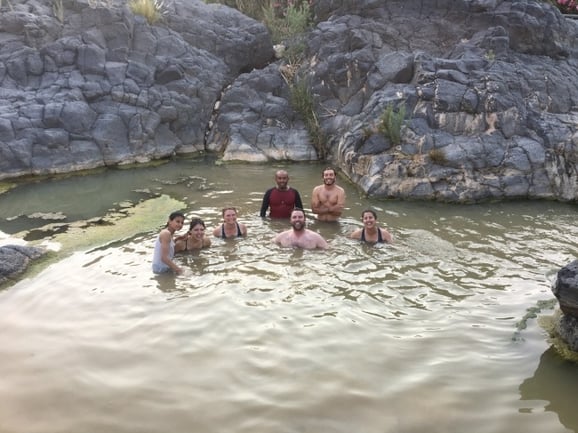
After a celebratory swim in the cool shallows of the wadi and the great sense of relief at having all made it, I retired to my tent and pulled out my sewing kit, but there was no fabric left to sew. My shredded hiking pants had fallen victim to the extreme terrain of Wadi Mujib, and so the next day, after climbing all the way back out of the opposite side of Wadi Mujib, I ditched my pants with a sad sigh.
Now that I have bled on the Jordan Trail, I feel even more committed to completing my thru-hike. Whether or not this was truly the most difficult part of the trail remains to be seen, but I can freely admit that Wadi Mujib quite literally kicked my butt.
After we had completed the section and were all comfortably seated around the campfire that night, Stuart finally confessed, “I think I have PTSD from watching you nearly fall off the cliff.”
“And I think I have PTSD from watching your reaction,” I replied, glad that my own face had remained inches from the ground. “I’m sure it looked far worse from where you were standing.” The others agreed—I had scared them pretty good.
We all stayed silent for a bit longer, listening to the fire snapping at the dry wood, and then Mohammad spoke, nodding at me with his knowing smile, and calling to me like he always does. “Nawaf!” he belted out, “Sheikh Nawaf!”
Follow my personal adventure on social media with #AndrewWalksJordan and #ThruJT and on the Andrew Walks Jordan homepage.




